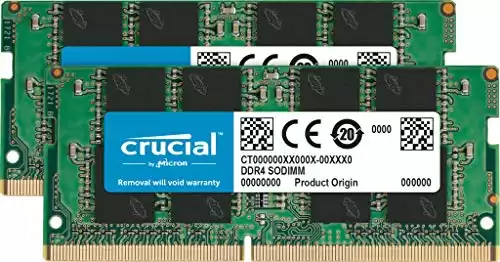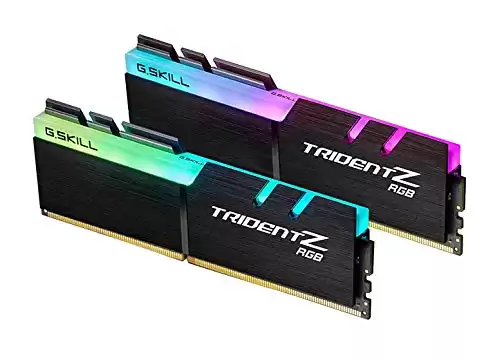It’s difficult to understate the importance of RAM in modern computing. Every day, millions of people access information stored in their computers’ memory.
Without a computer’s RAM, the programs and apps you run would have to rely on disk storage which can be up to a million times slower.
But if you want to create a system that runs faster, is more reliable, or consumes less power than the competition, high-performance memory is an important component of doing so.
But what about RAM frequency? Is it really all that important?
Let’s find out!
DDR4 3200 vs. 3600 – Which One Should You Get?
The sheer clock speed difference does not matter in most applications. What matters when choosing between 3200 and 3600 DDR4 RAM is the latency and whether the memory controller can extract the full potential from it. You should worry more about capacity, latency, heat, and power consumption. So, 3200 is better.
I ran quite a few tests and have concluded that there are very little to no applications which benefit from the increasing frequency of DDR4-2133 MHz or higher frequencies.
This means that buying DDR4-3600 would be a complete waste of money, since DDR4-3200 already gives excellent performance with great power efficiency at slightly lower power consumption and heat output, plus, 3200 DDR4 RAM costs considerably less than the 3600 version.
If your motherboard supports overclocking, this trend becomes even more pronounced, with practically all RAM kits being limited by BIOS to the rated speed.
You’re much better off spending that same money on a faster GPU or SSDs — this would benefit your rendering application far more than “faster” RAM.
What You Should Consider When Choosing Between 3200 MHz and 3600 DDR4 RAM
Here are some of the most important factors to consider when choosing between DDR4-3200 and DDR4-3600 RAM kits.
1- DDR4 RAM Capacity
RAM capacity is an essential element in a PC system. More RAM gives us the ability to handle greater amounts of information, which allows our computers to run faster.
The more information that can be stored directly in memory, the less hard drive usage there is, and the faster overall performance should be, but this isn’t always true.
A computer with 8 GBs of DDR4 RAM may perform just as well as one with 32 GBs if neither has enough memory for what we’re doing.
RAM Capacity Guidelines
When it comes to choosing PC RAM capacity, what frame of reference do we have? How much does RAM capacity affect performance?
64 GBs of DDR4 is a massive jump in system capability and cost over 16 GBs. If your budget allows for it, then that’s great!
On the other hand, if you only need 16 GBs, there might not be any point in getting more than that since it doesn’t contribute to better performance unless there’s a real need for it. But what exactly is “a real need”?
The amount of RAM you need depends on what kind of computer tasks you plan to make use of.
Computers with more RAM can handle greater workloads, but if your computer is unable to utilize that extra RAM, then it’s just spinning its wheels and using resources unnecessarily, such as consuming more battery power when it comes to laptops.
How much do you really need? If all you’re doing is checking email and browsing the web, 16 GBs will probably be fine for a considerable time to come.
The average user only uses about 10% of their system memory at any given moment, so having 2 or 3 times as much capability for when we do need it isn’t necessary right now.
When considering how much RAM capacity you’ll need in your next PC build, ask yourself these questions:
Remember that adding more RAM capacity doesn’t necessarily mean better performance, so don’t break the bank just because someone told you that 64 GBs is better than 16.
It may be true in some cases (which would make it an exception), but usually, having 2 or 4 times as much RAM as we need isn’t going to make our computers run noticeably faster.
Most people won’t see any difference at all unless they’re doing heavy multitasking, video/music editing, or other memory-demanding tasks.
If only 10% of memory is being used at any given time, then having 4 times more memory than your current usage isn’t always better.
For example: 8 GBs of RAM operating at 10% capacity is using only 800 MBs while 16 GBs @10% is using 1600 MBs. Even though the extra RAM may seem unnecessary now, it may be very useful in the future if you find that you’re running into that 10% limit often.
More CPU cores can also help with multitasking demands by allowing us to run multiple programs at once without slowing down our computers.
The bottom line is this: It’s important to know how much RAM we actually need when considering RAM capacity benchmarks for computer upgrades or new builds; don’t get duped into buying something “just because” everyone else is.
2- DDR4 RAM Latency
Let’s start with a technical definition of latency first, shall we? Latency is the time it takes for something to occur after you have initiated the process.
For example, firing an arrow from a bow has high latency because you have to pull back the string, aim, and let go before anything happens.
Waiting on hold when calling customer service has low latency because your request gets handled as soon as possible (even though that seems like an eternity).
Latency in computing is most often associated with storage (e.g., hard drive seek time ) but also pertains to memory access.
A RAM module’s latency measures how long it takes the data requested by the processor core to be returned.
As with all memory types, the lower the latency, the faster data can be served up to hungry cores.
RAM latency – sounds quite technical and imposing, right? But essentially, it’s just a measure of how long it takes for your RAM memory to return what you’ve asked of it.
The less time it takes, the better, and this is extremely important in gaming, especially if you want smooth experiences and very low input or reaction lags.
3- DDR4 RAM Heat Output
Most of our readers are probably familiar with the term “heat spreader” and what it does.
However, many have never thought about or realized that not all RAM is created equally in that aspect. Some manufacturers have developed different approaches to direct heat away from the top of the ICs to other areas on the modules for dissipation. That is, the heat spreaders should actually be called “heat dissipators” in some cases.
Heat is an important factor to consider in a computer, in many ways.
In all modern CPUs and GPUs, it dictates how high of an overclock one can get out of the components.
It also determines if a system is stable or not with whatever speeds are being pushed to them. A balance must be struck between cooling performance and noise levels, as well as keeping the noise down when overclocking components with two different approaches used in most parts: heatsinks and fans.
These usually battle each other for supremacy in any area that has both in it at some point or another.
When it comes to laptops, though, the confined space means that an OEM only has the option of using one or the other, and it takes a careful balance to make sure there is enough cooling going on to keep up with the components inside.
When it comes to computer RAM though, heatsinks are not particularly useful as they do next to nothing for VRM modules. In addition, memory ICs can be damaged by excessive heat very quickly, so dissipaters would seem to be the logical choice here.
However, a relatively new trend in DDR4 RAM is taking this idea a bit further and actually putting what amounts to metal fins over the top of them instead of spreading out the heating effects across an entire module surface.
This has been somewhat controversial among enthusiasts who have mostly been opting for more traditional designs up until this point, but is it really any better than just dissipating the heat on a whole module basis?
The bottom line is, as long as you stick with highly reputable RAM and cooling manufacturers and use somewhat sensible amounts of voltage (Don’t go overboard with it), you should be fine even with the heat spreaders on your RAM.
If you want to look at high-quality memory, check out this 3200 MHz DDR4 kit by G.Skill for desktops, or this one if you’re planning on upgrading your laptop.
4- DDR4 RAM power consumption
Another interesting aspect of RAM is its power usage because it’s directly related to one of the major issues every electronic system has: heat dissipation.
This should be especially concerning when powerful hardware is used in mobile devices such as laptops. Where OEMs are trying to reduce power usage and go fanless, although these goals are fundamentally conflicting.
Numerous studies exist about CPU’s power usage. However, there isn’t any study similar to this about RAM. On top of that, even if there were, lower-end systems usually don’t have access to them, making it impossible to measure their real-world power usage.
DDR4 modules are known to draw 1.2 watts of power at each memory module, compared with 1.5 watts per stick on DDR3 RAM, so they use up to 20% less power than DDR3 RAM.
Some high-performance modules may draw more, but most users can use DDR4 RAM without worrying about the extra power draw.
Just to be on the safe side, you should assume that DDR4 RAM will draw at least 3 W per 8 GB stick.
DDR4 3200 vs. 4200?
Not only would DDR4-4200 be a waste of money, but most people wouldn’t really need much more than 3200 MHz under most workloads.
The biggest difference between DDR4-3466 and higher versus DDR4-3200 is the price — it costs around $10 more per unit.
This might not be a lot for a single module, but if you are building a computer, then this quickly adds up to a significant amount of money that could have been spent on something else.
In those cases, I’d recommend going for DDR4 3200 instead because there is no measurable performance difference, and it will end up costing you a lot less.
What about G.Skill TridentZ RGB 4266 MHz?
At the moment, it doesn’t seem like there is any need to buy high-frequency DDR4 memory modules when you can have both higher capacity and better frequency for less — so yes, the hyper-expensive DDR4-4266 MHz kits (and even DDR4-4400) are completely pointless.
Perhaps in the future, their prices will drop or rise to meet whatever sort of performance increase they promise today, but at the moment, they don’t really do anything.
There simply isn’t any need for such incredibly high-frequency RAM today, no matter what standard it claims to follow.
It might have been worth paying attention if these kits had been priced even close to “reasonable”, but as it stands, they cost twice as much as DDR4-3200 and offer no real increase in performance or features.



